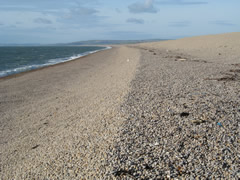Chesil Beach and the Fleet Lagoon
18 miles and 180 billion pebbles


Copyright Chesil Multi-
Last updated 1/11/24
The formation of Chesil Beach has been much discussed over the years and is still the subject of continuing debate. Continuing research yields further insights into the origin of the material that forms the beach and how it was transported to its current location. This page presents a summary of one current view suggested by Malcolm Bray of Portsmouth University. A more detailed document can be downloaded here.
Chesil Beach initially formed from predominantly sandy deposits in Lyme Bay as water levels rose rapidly at the end of the last ice age 20,000-
Sea levels stabilised 4000-
At this time relict cliffs in East Devon, left stranded by falling sea levels during the ice age, were re-
Coastal recession and human intervention have now depleted the beaches to the west of West Bay, resulting in increased prominence of the headlands. This has cut off the supply of material to Chesil Beach
Chesil Beach must now be regarded as a closed shingle system with no replenishment from outside sources. It is therefore sensitive to environmental changes such as rising sea levels. Ian West has suggested that Chesil Beach at Portland is moving eastward at around 15cm per year, with a much slower rate further north towards Abbotsbury.

